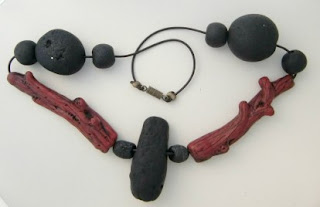Every once in a while you run across a brilliant idea that is so simple it just leaves you smacking yourself upside the head and muttering, "Of course!!?". I had always meant to look into hollow extruding. I don't often use my extruder because it's a little tedious--conditioning, assembling, cranking, etc. That being said, when I do drag it out, I generally have fun with it after a bit. So when I ran across bounty_gg's brilliant little one-page tutorial on how to easily convert your ordinary extruder dies into coring dies, I had to dash into the studio and try it out. (Yes, I do know that coring dies are made for most extruders--but being cheap, lazy, and the instant-gratification kind of girl I am, well, I'd rather cobble something up now than order it and wait.
Here's the link to the original tute: http://www.flickr.com/photos/bounty_gg/4006100573/in/faves-8989180@N02/
Her name is Galina and she is not only one sharp cookie, she is very generous with her ideas and discoveries.
So here is how you do this, with a makins or any other inexpensive hand extruder. Enjoy, experment, and post your addendums for everyone's benefit!
Most extruders have a 7-hole die--this is crucial.
Find a small screw or nail that fits easily into the center hole of the 7-hole die. Then find either flat washers with big holes or O-rings that fit into the retaining cap of the extruder. Fish out your medium size square, hexagonal, whatever shape dies that you want to for the final shape of the outside of the bead. (Why medium? because the clay goes through the 7-hole die first; if the final die is too large, the clay won't compress and you will end up with a handsome assortment of half-round worms.
See the illustrations below:


The sequence is was makes it all work--you must have space between your 'coring die' and your shape die.
So; left to right, Retaining cap, final shape die, spacers (either a couple of large-hole flat washers or O-rings), and coring die.
load them in in that order, load your conditioned clay into the barrel, screw the retaining cap on tight, and build up those biceps. Squeeze, baby! Or crank. Whatever.
If you used enough clay, your final extruded snake should be about 10" long, with a perfect hole running all the way through.
To make cores for hollow bangles, I wrap the core around a form and cut the ends flush, then smooth the join well and cure. It's far easier I find, to work with a solid bangle than two halves--I finish my bangles completely, right down to the final sand and polish, then warm it in the oven briefly, cut the halves apart (doesn't matter where the original seam was, really!!), and string my elastic cord through. I find this invariably gives me a near-invisible join when the bracelet comes back together over the wrist.
A couple of notes:
Mari O'Dell did a cool tute on hollow twisted beads a while back, and that's applicable these, too; especially the square shape. I find it best for put the extruded snake onto some type of support--thin rod, long needle, or even weed-wacker cord--anything that will keep the hole from collapsing, and gently twist into some very cool shapes.
(These look smashing when done in metallic colors like pearl-ex over black clay.
Cut into beads while still on the support if you want to avoid distortion.
Remember that if you extrude scrap clay as the core that the final bead/bracelet can be as large as you wish--you can also build up a middle layer with ultralight clay as a filler that will allow you to make really big items with little weight. (Do not build up to the inside of the braclet, or it won't fit.)I always cure my core before covering--it helps keep the holes intact. Just use a liquid clay like bake'n'bond, TLS or polypaste to adhere the next layer of raw clay.
Anyway, hope this gives you another arrow for the quiver--have a great Summer.
Namaste,
Randee






 Her screen name is Primatoide Futile, and her work is notable for the sophistication that she achieves with simple palletes and shapes--but what knocked me out was her elegant solution for the non-drillers among us--she simply combined two techniques--creating hollow tubes in polymer, then creating the twig around it;
Her screen name is Primatoide Futile, and her work is notable for the sophistication that she achieves with simple palletes and shapes--but what knocked me out was her elegant solution for the non-drillers among us--she simply combined two techniques--creating hollow tubes in polymer, then creating the twig around it;











